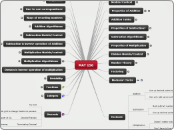MAT 156
Palya's Problem Solving Steps
1. Understand the Problem
2. Devise a Plan
3. Impliment your plan
4. Looking back
Sets
Equal sets
Equivalent Sets
Subset
Set complement
Proper Subset
Set intersection
Set union
Set difference
Models/Context
Discrete (set) Model- Counted quantities
Continuous(number line) Model- Measured quantities
Closure Property of addition
Closure property of addition on whole numbers(W)
Commutative property of addition on whole numbers (w)
Associative property of whole numbers(w)
Identity property of addition of whole numbers (w)
Addition Tables
use the commutative property
the numbers are diagonal and appear in bands
Properties of Subtraction?
Closure property of subtraction on whole numbers(w)
No
Commutative property of subtraction on whole numbers(w)
No
Associative property of subtraction on whole numbers(w)
No
Identity property of subtraction on whole numbers(w)
No
Subtraction Algorithiums
Scratch Method
European Method
Properties of Multiplication
Closure property of multiplication on whole numbers (w)
Commutative Property of multiplication on whole numbers(w)
Associative property of multiplication on whole numbers(w)
Identity proerty of multiplicatin on whole numbers(w)
Zero property of multiplication on whole numbers(w)
Distributive property of multiplication over addition/subtraction on whole numbers (w)
Division Models/Context
Partition (equal Sharing)
Measurement (repeated subtraction)
Number Theory
Even Numbers
The # is a multiple of 2, 2n
Odd numbers
if is one more than even #, 2n+1
Factoring
Prime Numbers
Composite Numbers
Use Cuisenaire Rods to visualize
Least Common Multiple
Use Cuisenaire Rods to visualize
Relatively Prime
Two numbers don't share any common factors
Addition
move clock wise
Arithmetic Proerties
Subtraction
subtract the number by moving counter clockwise
Multiplication
repeated addition
Arithmetic Properties
Division
Inverse multiplication
Decimals
addition
Line up decimal points to line up place value.
Can only add zero's to the left of the decimal.
Subtraction
Must subtract numbers in order given.
Line up decimal points
Multiplication
Doesn't matter which number is on top.
Don't have to line up decimals
Division
When you move the decimal point over on the divisor you have to do the same for the dividend.
After the decimal point the place value has th at the end.
Sequences
Arithmetic (common difference)
Rule: an=a1+d(n-1)
Geometric (common ratio)
Rule: an=a1 x r exponent n-1
Recurrence Relationship
current term is dependent on previous term
One-to-one correspondence
For each element of A there is an element of set B to match it with no extra elements and no repeated use of an element.
Ways of recording numbers
Tally System
Egyptian Symbols
Mayans (base 60)
Babylonians
Roman(Symbols in specific order)
Hindu-Arabic (usage of digits/numerals, and place values)
Base Blocks
Addition Algorithiums
Lattice Method
Scratch Method
Low Stress
Any column first
Left to Right Addition
Subtraction Models/Context
Take-away
Have initial quantity and remove a specified amount
Comparison
compare relative sizes of 2 quantities, determine how much larger or smaller one quantity is compared to the other.
Missing addend
Subtraction is inverse operation of Addition
Four Fact Families
Has two addition and two subtraction facts that go together
Multiplication Models/context
Multiplcation as repeated addition of whole numbers (discrete)
Repeated addition Continuous (number Line)
Area Model
Cartesian Product Context (Can use tree diagram)
Partial Product
Lattice Method
Division is inverse operation of multiplication
Four fact Families
Has two multiplication and two division facts that go together
Divisibility
Equivalant Statements
Tests
2
3
4
5
6
8
9
10
Array
Partial-Quotients
Scaffolding
Column
Interpretations
Part-Whole
2/3 Represents 2 parts of a whole that was divided into 3 parts.
Division
Copies of a Unit Fraction
Ratio
Pattern Blocks
Help Student visualize fractions when working with shapes.
Egyptian Fractions
all must be unique unit fractions
Write as a sum of unit fractions
Improper/Mixed
Simplified
Add/Subtracting
Improper method
Mixed fraction form
Multiplication
Area Model
Division
Parition(Long Division)
Repeated Subtraction (Division of Fractions)
Need to know the size of the group and find the number of groups
may look like fraction
Compares two quantities regardless of whether the units are same.
A quantitative relationship showing number of times one contains or is contained within another value.
Absolute Reasoning
Relative Reasoning
Proportion
A statement that 2 ratios are equal
Cross Multiplication
Shortcut to multiply both sides by LCD
Proportional Reasoning
Understand rational numbers
Ratio Sense
Unitizing
Reconizing quantities you have and how they change
Relative Thinking
Opposite of an integer
a and -a
number line approach
a,-a are both the same distance from zero
Chip method
Absolute Value
Number line approach
helps visualize
Chip method
Look for the magnitude of the number
Ordering integers
numbers to the left of -3 are less than<
numbers to the right of -3 are greater than >
Arithmetic with integers
Addition
use the discrete set model of addition
Subtraction
Take away model
Multiplication
Repeated addition
Division
Repeated subtraction model
Partition model
Per 100
Can use 100 grid to change fraction to percent.
Decimal Fraction
Whole number over a power of 10.
Terminating Decimal
A decimal that doesn't go on forever.
